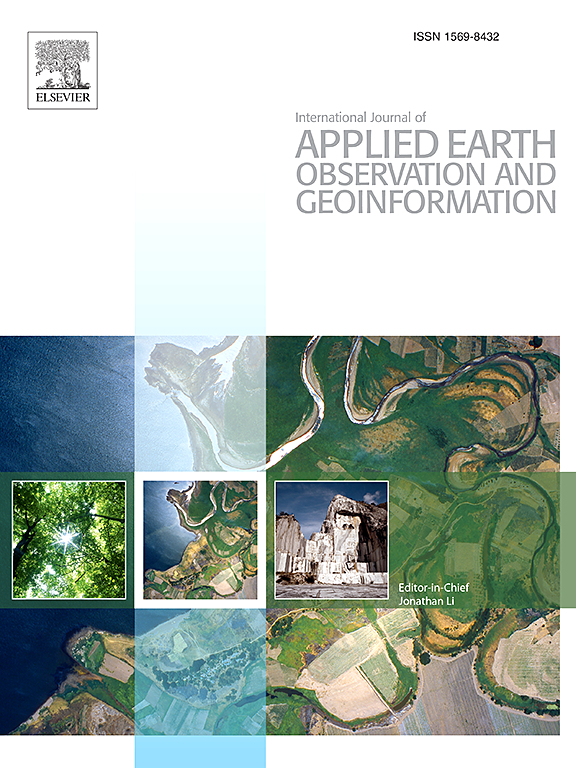Frequent drought and flood events in the Yellow River Basin, increasing future drought trends in the middle and upper reaches
IF 7.6
Q1 REMOTE SENSING
International journal of applied earth observation and geoinformation : ITC journal
Pub Date : 2025-04-11
DOI:10.1016/j.jag.2025.104511
引用次数: 0
Abstract
Under global warming, the Yellow River Basin (YRB), serving as an ecological barrier and climate-sensitive region in northern China, faces severe challenges such as frequent extreme droughts and floods, as well as intensifying water resource supply–demand conflicts. To systematically assess the evolution of droughts and floods in the YRB, this study utilizes observational data from 137 meteorological stations and CMIP6 scenario models, employing the dual-index system of the Standardized Precipitation Index (SPI) and Standardized Precipitation Evapotranspiration Index (SPEI) to quantitatively analyze historical drought and flood characteristics, and project future trends under different scenarios. The results indicate that both SPI and SPEI effectively identify drought and flood events, with SPEI demonstrating superior sensitivity to extreme droughts and floods due to its integration of evapotranspiration effects. From 1956 to 2020, the basin’s drought index increased at a rate of 0.003–0.025 per decade, while the flood index changed at a rate of −0.006–0.039 per decade. Droughts were frequent in the middle and upper reaches (30.61 % severe droughts), while flood risks were prominent in the lower reaches (6.25 % extreme floods). Under SSP3-7.0 and SSP5-8.5 scenarios, drought-dominated patterns intensified (severe droughts reaching 62.92 %), and extreme floods showed an increasing trend in the middle and lower reaches. Therefore, the middle and upper reaches should prioritize building drought-resilience systems; the southern and lower reaches should enhance flood-defense infrastructure. Reservoir operations should be optimized using 1–6 months of drought and flood warnings and coupled with groundwater replenishment strategies for 12–24 months of drought cycles.

黄河流域旱涝事件频发,未来中上游干旱趋势加剧
在全球变暖背景下,黄河流域作为中国北方的生态屏障和气候敏感区,面临着极端干旱和洪涝灾害频发、水资源供需矛盾加剧等严峻挑战。为系统评价长江三角洲旱涝演变,利用137个气象站的观测资料和CMIP6情景模型,采用标准化降水指数(SPI)和标准化降水蒸散指数(SPEI)双指标体系,定量分析了长江三角洲旱涝历史特征,并预测了不同情景下的未来趋势。结果表明,SPI和SPEI均能有效识别干旱和洪水事件,其中SPEI由于综合了蒸散发效应,对极端干旱和洪水的敏感性更高。1956 ~ 2020年,流域干旱指数以- 0.003 ~ 0.025 / a的速率增加,洪水指数以- 0.006 ~ 0.039 / a的速率变化。中上游干旱频发(30.61%为严重干旱),下游洪涝风险突出(6.25%为极端洪涝)。在SSP3-7.0和SSP5-8.5情景下,干旱主导模式增强(严重干旱占62.92%),中下游极端洪水呈增加趋势。因此,中上游应优先建设抗旱系统;南部及下游应加强防洪基础设施建设。应利用1-6个月的旱涝预警和12-24个月干旱周期的地下水补给策略来优化水库作业。
本文章由计算机程序翻译,如有差异,请以英文原文为准。
求助全文
约1分钟内获得全文
求助全文
来源期刊

International journal of applied earth observation and geoinformation : ITC journal
Global and Planetary Change, Management, Monitoring, Policy and Law, Earth-Surface Processes, Computers in Earth Sciences
CiteScore
12.00
自引率
0.00%
发文量
0
审稿时长
77 days
期刊介绍:
The International Journal of Applied Earth Observation and Geoinformation publishes original papers that utilize earth observation data for natural resource and environmental inventory and management. These data primarily originate from remote sensing platforms, including satellites and aircraft, supplemented by surface and subsurface measurements. Addressing natural resources such as forests, agricultural land, soils, and water, as well as environmental concerns like biodiversity, land degradation, and hazards, the journal explores conceptual and data-driven approaches. It covers geoinformation themes like capturing, databasing, visualization, interpretation, data quality, and spatial uncertainty.
 求助内容:
求助内容: 应助结果提醒方式:
应助结果提醒方式:


